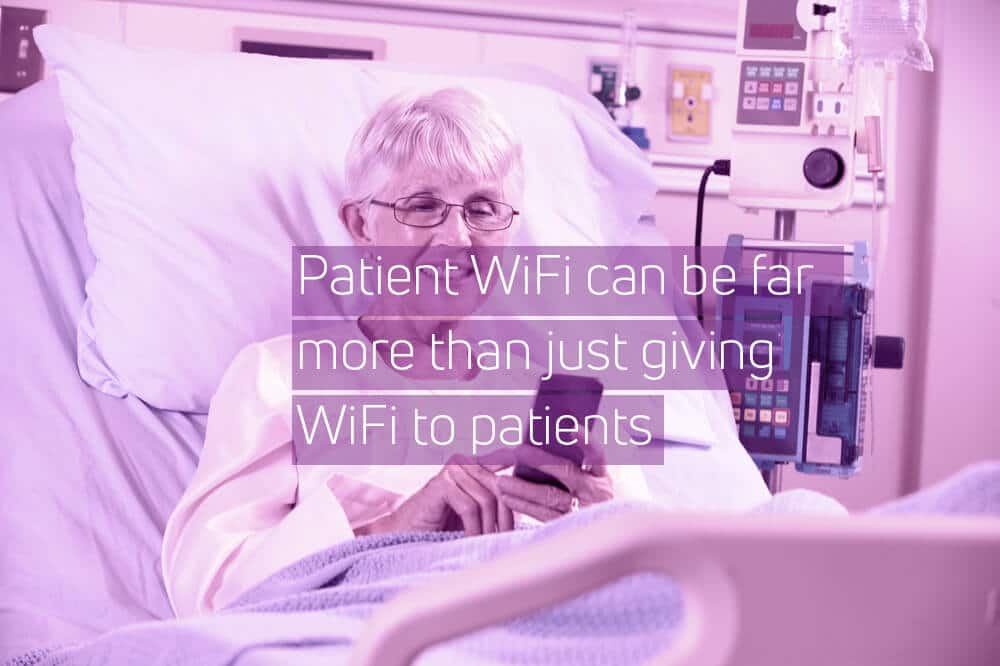With the directive to rollout mandatory patient WiFi, NHS Digital offered general guidance on what must be achieved, but no official direction on how to achieve it.

By leaving Trusts to solve the problem independently, IT infrastructure experts expected many to take a short sighted “box ticking” view, extending 3rd party patient WiFi contracts, and adding an overlay with the aim of simply becoming compliant.
Instead, the rollout has seen many Trusts maximising the opportunity by investing the cash injection in their infrastructure and achieving further reaching, longer term benefits than they, or the industry, ever expected. With careful planning, the mandatory WiFi infrastructure has been shared as a secure, medical grade multi-purpose wireless network. Improving services and reducing costs, this forward-thinking budget utilisation is offering better outcomes for both patients and staff, adding operational and financial value to the NHS.
Achieving Compliance – Keeping it Simple
NHS Digital’s aim with this rollout is comprehensive – to achieve regulatory compliance, every Trust must deliver a secure, stable and reliable infrastructure. The solutions must include authentication, guest access, logical traffic separation, an assured level of service availability and security, protected access to related network infrastructure, automated enrolment, an acceptable use policy, robust registration, content filtering and provision of remote monitoring to manage usage. Login must be through a branded portal, and mandatory usage reports must be delivered to NHS Digital on a regular basis.
While this may sound burdensome, CAE have created several propositions to simplify the rollout within a Trust environment. They are quick and easy to deploy and integrate, minimising disruption and automating data capture and reporting. The solutions identify necessary hardware, software and licenses, and offer ongoing 24/7 support once the infrastructure is in place.
Achieving More – Maximising the Budget
Trusts are aiming to utilise the new infrastructure to positively impact patient care. Realising that the project can provide more than just effective public access to WiFi, Trusts are using the infrastructure as a platform upon which to deliver innovation.
Other, more advanced services being added include:
- Wayfinding Applications: Patients and relatives can be directed with maps around the hospital – in any language – reducing stress and anxiety. By guiding patients efficiently around the building, Trusts benefit from a reduction in missed appointments (DNAs) and late arrivals.
- RFID Equipment Tracking: RFID tagging increases operational efficiency and reduces costs due to loss and theft by locating medical equipment. Porters and ward staff are able to quickly locate the closest resource required providing increased efficiency on the wards.
- Reduced Paperwork: By offering staff real time mobile access to patient records and allowing them to use mobile devices to update those records on ward rounds, both paperwork and errors can be minimised.
- Efficient Resource Allocation: Real-time analytics and insights including patient waiting times, repeat visits and congested areas allow Trusts to more effectively allocate staff and equipment for improved service delivery and patient care.
- Staff Security: In secure mental health settings, RFID lanyards have been issued for staff safety. Once an alarm button is pressed, the staff member’s location can be accurately established – a huge improvement on broader bleeper tracking.
- Improved Communication and Feedback: Relevant clinical messages can be sent to target groups or individuals, and location data can be utilised, so patients can be asked for feedback – such as the NHS Friends and Family Test – as they are leaving the premises.
- Improved Patient Satisfaction: Whilst the WiFi rollout itself improves patient happiness and wellbeing by allowing contact with loved ones, Trusts are using the network to offer patients improved entertainment options and access to relevant educational health information and services, freeing up clinical time and reducing costs.
With NHS Digital’s 5 Year Forward View detailing plans for paperless patient records by 2020, other expected future requirements include greater use of e-prescribing, increased e-referrals for hospital appointments, online GP appointment booking and accessible online medical notes for every NHS user in England.
Careful investment in infrastructure now offers not only complete, current regulatory compliance, but is also an easy way to support and benefit the Trust over the coming years.
Experts in secure and NHS compliant WiFi infrastructure planning, installation, maintenance and support, CAE offers free WiFi audits to NHS Trusts.
For more information, contact CAE.


